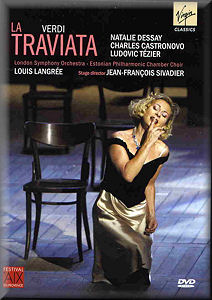|


alternatively
MDT
AmazonUK
AmazonUS
|
Giuseppe VERDI (1813-1901)
La Traviata - opera in three acts (1853)
 Violetta Valéry, a courtesan – Natalie Dessay (soprano); Flora,
her friend – Silvia de la Muela (mezzo); Annina, her maid – Adelina
Scrabelli (soprano); Alfredo Germont, an ardent admirer – Charles
Castronovo (tenor); Giorgio Germont, his father – Ludovic Tézier
(baritone); Gastone, Visconte de Letoirieres – Manuel Nunez Camelino
(tenor); Doctor Grenvil - Mario Lo Poccalo (bass); Baron Duphol,
an admirer of Violetta – Kostas Smoriginas (baritone)
Violetta Valéry, a courtesan – Natalie Dessay (soprano); Flora,
her friend – Silvia de la Muela (mezzo); Annina, her maid – Adelina
Scrabelli (soprano); Alfredo Germont, an ardent admirer – Charles
Castronovo (tenor); Giorgio Germont, his father – Ludovic Tézier
(baritone); Gastone, Visconte de Letoirieres – Manuel Nunez Camelino
(tenor); Doctor Grenvil - Mario Lo Poccalo (bass); Baron Duphol,
an admirer of Violetta – Kostas Smoriginas (baritone)
Estonian Philharmonic Chamber Choir
London Symphony Orchestra/Louis Langrée
rec. live, Théâtre de l‘Archevêché, Aix-en-Provence Festival, July
2011
Sound: PCM Stereo, dts-HD 5.1 Surround
Picture: 16:9/NTSC
Region: 0 (worldwide)
Subtitles: Italian (original language), English, German, French,
Spanish
 VIRGIN CLASSICS
VIRGIN CLASSICS  730798 9 [139:00]
730798 9 [139:00]
|
I first came across La Traviata as a teenager sitting
in the pit orchestra for an amateur production in Leicestershire.
The tuneful, dramatic music and touching story immediately made
a huge impact. It actually converted me to opera and because
of this La Traviata has always been very special to
me. This DVD captures a performance of a new production by the
French director Jean-François Sivadier and very good it is too.
It was staged in the open air in Aix-en-Provence and the excitement
of the occasion is palpable.
It’s dominated by the Violetta of Natalie Dessay and the Alfredo
of American tenor Charles Castronovo. They are complemented
by the excellent French baritone Ludovic Tézier as Giorgio Germont
and a vivacious supporting cast. From the offset, the diminutive
Dessay sets the tone. Her Violetta is a lively, attractive,
modern young woman living life to the full. Very early on it’s
also pretty clear that all is not what it seems and she doesn’t
have long to live. The chemistry between her and Alfredo is
obvious from their first meeting - the smiles and sideways glances
at each other are well captured by the cameras. Violetta’s confused
state of mind, caused by her meeting with Alfredo, is wonderfully
done both dramatically and musically. As a couple they are believable
and likeable. Because of this the viewing audience is immediately
concerned about the outcome of their relationship. You become
increasingly drawn into the action. Credit for this level of
believability and realism must also be given to the director
Jean-François Sivadier.
The production uses modern dress and the stage itself is uncluttered
with minimal scenery. It works really well. The minimalist approach
actually concentrates the mind on the unfolding drama. The drama
itself is wonderfully managed and there are many little details
that bring the whole thing to life. One example is the Act 1
Brindisi, where one of the cast actually stage directs
Alfredo. This also occurs in other parts of the opera as it
unfolds. The cast are also their own stage hands, moving chairs
around the stage and unfurling the back-drops. It’s very refreshing.
Now to Violetta. What a performance this is! Her decline from
vivacious party animal to sickly dying woman is quite shocking.
During the Prelude to Act III she slowly removes her wig and
all of a sudden the reality of her situation is brought home
with harrowing, devastating effect. If her final duet with Alfredo
doesn’t bring a tear to your eye then you must have a heart
of stone. As a dramatic portrayal, Dessay’s performance is outstanding.
Musically it’s just as good. She owns the stage - Oh dear, I’ve
become an X Factor judge! This is a star in action, of that
there can be little doubt. It takes two to tango to bring this
opera fully to life and Castronovo turns in a great performance
alongside her. The orchestral contribution by the LSO conducted
by Louis Langrée is top class. The sound quality is good rather
than excellent. There is some manipulation of the balance with
intimate moments being boosted and the louder sections cut back.
The audience is quiet and there is some ambient background noise
- don’t forget that it was staged outdoors - but it’s not very
noticeable. Visually the DVD production is clean, fresh and
involving. Close action is well caught but it’s not all in your
face. There are plenty of wide shots to give a complete overview
of the stage when appropriate. This is a superb production and
well worth seeking out.
John Whitmore
see also review by Robert
Farr
|

